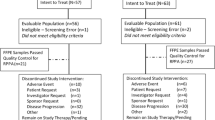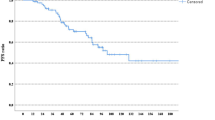Abstract
The study was planned to compare, in a prospective double-blind randomized trial, the efficacy and safety of toremifene (TOR) and tamoxifen (TAM) in post-menopausal patients with advanced breast cancer who have not had prior systemic therapy for advanced disease. Four hundred and fifteen post-menopausal patients with oestrogen receptor (ER)-positive or ER-unknown advanced breast cancer were randomly assigned to receive daily either 60 mg TOR or 40 mg TAM. The patients were stratified to measurable and non-measurable but evaluable groups. They were assessed for response to therapy, time to progression (TTP), time to treatment failure (TTF), response duration, overall survival and drug toxicity. Two hundred and fourteen patients were randomized into TOR and 201 into TAM treatment. The response rate (complete + partial) was 31.3% for TOR and 37.3% for TAM (P = 0.215). The 95% confidence interval (CI) for the 6% difference was -15.1% to 3.1%. The median TTP was 7.3 months for TOR and 10.2 months for TAM (P = 0.047). The 95% CI for the hazard ratio of 0.80 was 0.64-1.00. A percentage of the TOR patients (9.8%) and the TAM patients (18.9%) discontinued the treatment prematurely (P = 0.011) for various reasons. Consequently, the median TTF of 6.3 vs 8.5 months did not differ significantly (P = 0.271). The hazard ratio was 0.89 and the subsequent 95% CI 0.73-1.09. The median overall survival was 33.0 months for TOR and 38.7 months for TAM (P = 0.645). The hazard ratio was 0.94 with 95% CI of 0.73-1.22. The transient difference in TTP may be related to an imbalance in ER content of the tumours. When only patients with ER-positive tumours were considered (n = 238), no difference between two treatments was seen (P = 0.578). TAM was associated with an overall slightly higher frequency of adverse drug reactions than TOR (44.3 vs 39.3%) and a higher discontinuation rate due to these events (3.5% vs 0.9%). Treatment-emerged moderate dizziness (P = 0.026) and cataracts (P = 0.026) were more frequent among TAM than among TOR patients. In conclusion, TOR (60 mg day(-1)) and TAM (40 mg day(-1)) are equally effective and safe in the treatment of advanced post-menopausal ER-positive or ER-unknown breast cancer.
This is a preview of subscription content, access via your institution
Access options
Subscribe to this journal
Receive 24 print issues and online access
$259.00 per year
only $10.79 per issue
Buy this article
- Purchase on Springer Link
- Instant access to full article PDF
Prices may be subject to local taxes which are calculated during checkout
Similar content being viewed by others
Author information
Authors and Affiliations
Rights and permissions
About this article
Cite this article
Pyrhönen, S., Valavaara, R., Modig, H. et al. Comparison of toremifene and tamoxifen in post-menopausal patients with advanced breast cancer: a randomized double-blind, the 'nordic' phase III study. Br J Cancer 76, 270–277 (1997). https://doi.org/10.1038/bjc.1997.375
Issue Date:
DOI: https://doi.org/10.1038/bjc.1997.375
This article is cited by
-
Toremifene and tamoxifen have similar efficacy in the treatment of patients with breast cancer: a meta-analysis of randomized trials
Molecular Biology Reports (2014)
-
Phase III randomized trial of toremifene versus tamoxifen for Japanese postmenopausal patients with early breast cancer
Breast Cancer (2014)
-
Effects of toremifene versus tamoxifen on breast cancer patients: a meta-analysis
Breast Cancer (2013)
-
A comparison of survival outcomes and side effects of toremifene or tamoxifen therapy in premenopausal estrogen and progesterone receptor positive breast cancer patients: a retrospective cohort study
BMC Cancer (2012)
-
Pharmacokinetic analysis of a combined chemoendocrine treatment with paclitaxel and toremifene for metastatic breast cancer
Breast Cancer (2009)



